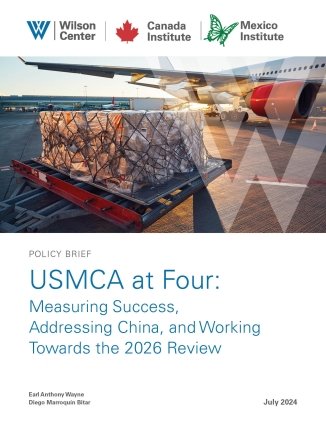USMCA at Four: Measuring Success, Addressing China, and Working Towards the 2026 Review


Since coming into force on July 1, 2020, the United States-Mexico-Canada Agreement (USMCA) has undergone a trial by fire and delivered remarkable results. Despite the COVID-19 crisis, Russia’s invasion of Ukraine, and rising tensions with China, goods and services trade within North America has soared by 50% and investment in new ventures has grown by 136%.
Representing a third of the world’s Gross Domestic Product, USMCA's stable and enforceable framework has successfully addressed multiple trade disputes, eliminated supply chain bottlenecks, and channeled unresolved differences into agreed-upon problem-solving channels. The trade agreement is at the forefront of an ongoing paradigm shift in globalization, where the focus has moved from reducing costs and maximizing efficiency to emphasizing sustainability, transparency, resilience, and reliability.
The agreement’s fourth anniversary offers a valuable opportunity to amplify the advantages of USMCA’s rules-based approach to trade and investment. In its initial years, NAFTA’s successor has supported greater prosperity for all three countries. However, much work remains to fulfill the commitments and opportunities built into USMCA. Several major disputes still need resolution, and significant challenges lie ahead.
Ongoing national elections, as exemplified by current developments in Mexico, can introduce policy and reform proposals that profoundly impact USMCA and the region’s integration prospects. Several proposed reforms in Mexico would directly impact USMCA’s implementation. Mexico’s proposed judicial reforms have raised serious concerns about legal certainty and the independence of judges, potentially affecting USMCA's performance, the country's rule of law and governance framework. The US and Canadian elections might also bring proposals that could impact the trade agreement, as indicated by former President Trump’s suggestions about a flat 10% tariff on all imports. Closely monitoring these developments in the coming months will be essential.
This brief, sponsored by the Wilson Center’s North American Institutes, outlines USMCA’s primary accomplishments in trade, investment, and job creation as it reaches the four-year mark. It also presents a forward-looking agenda aimed at leveraging opportunities and addressing current challenges, which are essential for unlocking the agreement’s full potential and ensuring a successful review in 2026.
About the Authors

Mexico Institute
The Mexico Institute seeks to improve understanding, communication, and cooperation between Mexico and the United States by promoting original research, encouraging public discussion, and proposing policy options for enhancing the bilateral relationship. A binational Advisory Board, chaired by Luis Téllez and Earl Anthony Wayne, oversees the work of the Mexico Institute. Read more

Canada Institute
The mission of the Wilson Center's Canada Institute is to raise the level of knowledge of Canada in the United States, particularly within the Washington, DC policy community. Research projects, initiatives, podcasts, and publications cover contemporary Canada, US-Canadian relations, North American political economy, and Canada's global role as it intersects with US national interests. Read more















